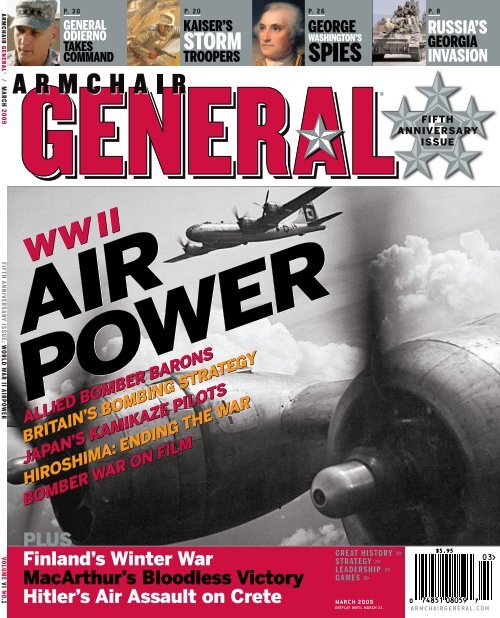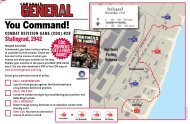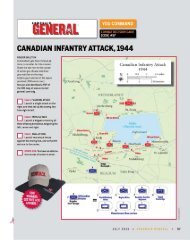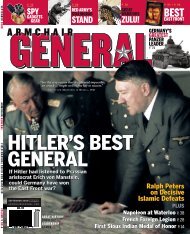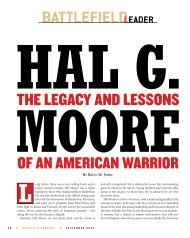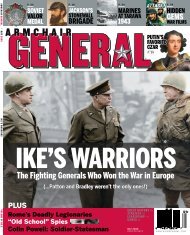Here - Armchair General
Here - Armchair General
Here - Armchair General
Create successful ePaper yourself
Turn your PDF publications into a flip-book with our unique Google optimized e-Paper software.
ARMCHAIR GENERAL ® / MARCH 2009 FIFTH ANNIVERSARY ISSUE: WORLD WAR II AIRPOWER VOLUME VI NO.1P. 3 0GENERALODIERNOTAKESCOMMANDP. 20KAISER’SSTORMTROOPERSPLUSFinland’s Winter WarMacArthur’s Bloodless VictoryHitler’s Air Assault on CreteP. 26GEORGEWASHINGTON’SSPIES®GREAT HISTORY >>STRATEGY >>LEADERSHIP >>GAMES >>MARCH 2009DISPLAY UNTIL MARCH 31P. 8RUSSIA’SGEORGIAINVASIONFIFTHANNIVERSARYISSUEARMCHAIRGENERAL.COM
CONTENTSFebruary / March 09VOLUME VI ISSUE 1COVER STORY42 World War II’s Bomber BaronsThe strategic bombing campaigns of three key Allied leaders,Harris, Spaatz and LeMay, turned German cities to rubbleand reduced Japan to ashes. By Jeffrey C. PraterFEATURESYOU ARE THERE28 MacArthur at Buna, 1942Eavesdrop on <strong>General</strong> Douglas MacArthur during one ofmilitary history’s great moments.TEN QUESTIONS30 <strong>General</strong> Raymond T. OdiernoAn exclusive interview with the commander of Coalitionforces on the front line in the War on Terrorism in Iraq.By Lieutenant Colonel Bradley T. Gericke, PhD, andCaptain Seth BodnarHISTORY IN DEPTH34 Hiroshima ReconsideredConflicting American demands – for the enemy’s “unconditionalsurrender” and for the demobilization of the meansto achieve it – made the atomic bombing of Japan inevitable.By Michael D. PearlmanINTERACTIVECOMBAT!51 Winter War, 1939Choose the correct course of action as Finnish troops facethe invading “Russian bear.”YOU COMMAND54 German Glider Assault on Crete, 1941Test your combat decision-making skills as the commander ofa German glider battalion attacking the British-heldisland of Crete.YOU COMMAND SOLUTION60 Aussies at Buna, 1942Historical outcome and winning Reader Solutions toCDG #29, November 2008 issue.WHAT NEXT, GENERAL?64 Arthur “Bomber” Harris, 1942<strong>Armchair</strong> <strong>General</strong> challenges YOU to devise a winningstrategy for the Royal Air Force’s bombing campaign againstNazi Germany! By Richard N. Armstrong<strong>Armchair</strong> <strong>General</strong>® (ISSN 1546-055X) is published bimonthly by <strong>Armchair</strong> <strong>General</strong>®, LLC, 4165 E. Thousand Oaks Blvd., Suite255, Thousand Oaks, CA 91362. Periodicals Postage paid at the Thousand Oaks Post Office and at additional mailing offices. Subscriptionrate is $29.95 for 6 issues (one year). Subscriptions sent outside of U.S. must be prepaid in U.S. funds with an additional$12 for surface postage and $20 for airmail postage. For Customer Service e-mail us at subscriptions@armchairgeneral.comor call us at (800)755-1366 or (386)246-3456. Canadian Post International Sales Agreement #40852014. POSTMASTER: Sendaddress changes to <strong>Armchair</strong> <strong>General</strong>®, P.O. Box 420235, Palm Coast, FL 32164-0235. Copyright ©2008. <strong>Armchair</strong> <strong>General</strong>®, LLC.All rights reserved. No part of this publication may be reproduced or transmitted in any form or by any means, electronic,mechanical, including photocopy, recording, or any information storage and retrieval system, without written permission.The views expressed herein are those of the authors and are not necessarily those of <strong>Armchair</strong> <strong>General</strong>®, LLC.4 PUBLISHER’S NOTE5 EDITOR’S LETTER6 MAILBAG8 CRISIS WATCHLearning From GeorgiaIt’s time to rethink futureweaponry. By Ralph Peters10 DISPATCHESReal heroes, collector’s corner,significant events in historyand much more!16 FORGOTTEN HISTORYImperial Dreams: JapanInvades Korea, 1592-98Japan’s first spasm of expansionistaggression has largelybeen forgotten.18 LEGENDARY COMBAT UNITSKamikaze!Japan’s Special Attack Unitsswept like a “divine wind”through Allied fleets in thePacific War.20 GREAT WARRIORSGerman World War IStorm TroopersThe Kaiser’s elite assault troopspioneered innovative tacticsthat evolved into WorldWar II’s blitzkrieg.22 BADGES OF HONORLegion of MeritCreated during World War II,this U.S. medal recognizesexceptionally meritoriousconduct.DEPARTMENTS24 HARD CHOICESMacArthur’s BloodlessVictoryU.S. troops confronted angryAmerican war vets in thestreets of Washington, D.C.,in 1932.26 SPY WARSThe Culper RingGeorge Washington’s spieswere the unsung heroes of theRevolutionary War.80 LEADERCurtis E. LeMay,Air Force LegendREVIEWS73 GAME BUZZThe scoop on some of today’slatest titles!74 VIDEO GAME REVIEWMercenaries 2:World in Flames75 WARGAME REVIEWGary Grigsby’s War Betweenthe States and Birth ofAmerica 2: Wars in America76 BOOKSHELFWarlordCarlo D’Este’s new must-readbiography of Winston Churchill.78 DVD LIBRARYBomber War on FilmA dozen films depicting WorldWar II’s bomber campaigns.ON THE COVER1944. Boeing B-29Superfortressesconduct a bombingmission over theMariana Islandsduring World War II.COVER: LOOMIS DEAN/U.S. ARMY AIR SERVICES-PACIFIC ARENA AREAS/TIME & LIFE PICTURES/GETTY IMAGES2 ✯ ARMCHAIR GENERAL ✯ MARCH 2009
LEGENDARY COMBAT UNITSKAMIKAZE!Japan’s Special Attack Unitsswept like a “divine wind” through Allied fleetsin the final year of the Pacific War.April 11, 1945. AJapanese kamikazeattacks the USSMissouri as thevessel operatesoff the coast ofOkinawa. The planehit the side of thebattleship, belowthe main deck, causingminor damage.In the summer of 1944, as LieutenantCommander Tadanao Miki of Japan’sAeronautical Research Laboratory struggledto develop an effective guidance systemfor a new “flying bomb” design,Sub-lieutenant ShoichiFAST FACTSOta offered him a solution: Put pilotsinside the deadly rockets. AlthoughOta’s suggestion for a foolproofguidance system horrified Miki, seniorJapanese navy and army officersfavored the idea that piloted suicideaircraft might turn the tide of thewar back in Japan’s favor.Since the earliest days of thewar, pilots (on both sides) had occasionallysacrificed themselves insuicide attacks. But with the conflictincreasingly going badly forJapan, such attacks became officialpolicy. Special Attack Units – commonlycalled kamikaze – beganforming to wreak destruction onthe powerful Allied fleets surgingever closer to Japan’s home islands.The first “official” kamikaze sortiesby a Tokubetsu Kogeki Tai (SpecialAttack Unit) took place in theDESIGNATION:Special Attack UnitsNICKNAME: Kamikaze(divine wind)ESTABLISHED: Oct. 19,1944 (the first formalunit, the 201st FlyingGroup, was comprisedof 24 volunteers; othernavy and army unitsformed later)NOTABLE CAMPAIGNSAND BATTLES: LeyteGulf, Oct. 23-26, 1944;Iwo Jima, Feb. 19-Mar.26, 1945; Okinawa,April 1-June 23, 1945NOTABLE KAMIKAZESTRIKES: USS St. Lo, USSMissouri, USS Saratoga,USS Essex, USS BunkerHill, USS FranklinOTHER KAMIKAZEWEAPONS: Ohka flyingbomb, Kaiten midgetsubmarine, speedboatsPhilippines in October 1944, principally atthe Battle of Leyte Gulf. By early 1945kamikazes had struck seven American aircraftcarriers and sank or damaged 40 otherNATIONAL ARCHIVESships. Far more effective than theconventional sorties by the thennearly impotent Japanese navy,these attacks quashed any remainingdebate about the value ofkamikazes versus the time andmoney wasted on training pilotsand building combat aircraft. Infact, the program was expanded intime to undergo its next major testoff the shores of Okinawa.In waves of persistent aerial attackstermed Operation Kikusui(Floating Chrysanthemums),kamikaze strikes began in the watersoff Okinawa on April 6, 1945.Initially concentrated against thescreen of lightly armored destroyersand escorts 50 miles from theAllies’ main fleet, the suicide attacksoften devastated these smallerships. (The USS Laffey was struckApril 15 by four bombs and sixkamikazes; remarkably it remainedafloat, although nearly a third of its crewwere killed or wounded.)The Japanese eventually focused on thelarger vessels of the main fleet. Wave after waveof kamikaze planes struck the Allied ships untilthe Battle of Okinawa ended in June 1945.All told, 1,450 Japanese aircraft took to the airagainst the Allied fleet, killing almost 5,000Sailors and wounding nearly that number.Over 350 Allied ships and landing craft weredamaged and 36 were sunk. However, of theseveral aircraft carriers (including the heavilydamaged Franklin) and battleships that werehit, none was sunk. Kamikaze attacks contin-18 ✯ ARMCHAIR GENERAL ✯ MARCH 2009
SPY WARSThe Culper RingGeorge Washington’s spies were the unsung heroes of the Revolutionary War.The Culper Ring, a smallgroup of men who served as<strong>General</strong> George Washington’sprivate “intelligencers”(as Washington dubbedthem) for nearly the durationof the War of Independence, was the mostaccomplished of any American (or British)intelligence network of that momentousstruggle. Long, intimate correspondence betweenthe ring members and Washington revealsnot only their individual characters butalso an appreciation of how ordinary mencan perform the most extraordinary deedswhen called upon by circumstance.A BOLD PLANAt the outbreak of the Revolution inAbove: September 22, 1776.Nathan Hale, considered one ofAmerica’s first spies, is hanged inNew York City following his captureby the British. In the early days ofthe Revolution, spying was riskybusiness, as many operativeswere killed or turned into doubleagents working for the British.Right: Benjamin Tallmadge becameGeorge Washington’s chief intelligenceofficer in 1778. Tallmadge and his fellowspy ring members from Setauket, Long Island,provided Washington with crucial informationthroughout the war.1775, there was not a single professionalagent or trained intelligence officer in thePatriot ranks. No spy agency of any sort existed,nor were there instruction manuals toteach even the most basic spy craft. In short,no one knew how to spy.Yet from mid-1776, George Washingtondesperately needed eyes and ears inNew York, the key stronghold of theBritish Empire in America. The city wasthe primary transit point for fresh troopsand was a major naval base in its ownright. Thus in a bid to gather intelligencethat summer, Washington sent NathanHale into this enemy-held territory. Hale’sbrave mission, however, was a fiasco thatended with his hanging.Throughout 1777, as Washington led hisbattered army away from the city,he strove to find ways to improveAmerican intelligence. New Yorknevertheless remained a stubbornlydifficult nut to crack.Washington occasionally sent ininexperienced operatives, but theyrarely returned – and when theydid, it was impossible to knowwhether their information was accurateor even if they had becomedouble agents for the British.In mid-1778 a young dragoon officernamed Benjamin Tallmadge proposed adaring solution to Washington’s quandary:Instead of sending men on quick in-andoutreconnaissance missions, Washingtoncould permanently station agents behindenemy lines, where they could pose astrusted Tory Loyalists and gather valuableintelligence.THE CULPER SPIESTallmadge’s first two recruits were AbrahamWoodhull, a farmer, and Caleb Brewster,a fiery whaleboatman. The latter, in particular,enjoyed nothing more than riskinghis life if it entailed a chance to fight againstthe British. Austin Roe, a tavern keeper wholiked his tipple, soon joined the nascent network.Importantly, Tallmadge had known allthree of his agents since childhood, as theywere from his hometown of Setauket, LongIsland. Indeed, one reason British intelligencewas never able to penetrate the CulperRing was that its members never workedwith anyone whose trustworthiness theycould not personally verify.Woodhull, codenamed Samuel Culper,originally acted as the organization’s leaderon Long Island, traveling back and forth toNew York to pick up information aboutBritish troop movements and to observenaval maneuvers. However, Woodhull was acongenitally anxious man, and he spentmuch of the war close to a nervous breakdown.The pressure soon became too greatfor him to bear, so he stayed in New Yorkwhile Roe took over as courier and Brewstertook charge of evading British sea patrols onLong Island Sound to get Woodhull’s messagesto Tallmadge, now based on the southshore of American-held Connecticut.Yet Tallmadge realized he needed a wellplacedsource in New York to replace Woodhull,who was desperate to return to hisfarm. In the summer of 1779 Tallmadgefound his man: Robert Townsend, a wealthymerchant from Oyster Bay, Long Island,who had come to know Woodhull duringWoodhull’s sojourns in the city. Townsendboasted powerful connections with BritishBOTH IMAGES: LIBRARY OF CONGRESS PRINTS AND PHOTOGRAPHS DIVISION26 ✯ ARMCHAIR GENERAL ✯ MARCH 2009
10 QUESTIONS<strong>General</strong> Raymond T. OdiernoCommander, Multi-National Force – IraqAn exclusive interview with the U.S. Army general commandingCoalition forces on the front line in the War on Terrorism.On September 16, 2008, <strong>General</strong>Raymond T. Odiernoassumed command of theMulti-National Force – Iraq(MNF-I), replacing <strong>General</strong>David Petraeus, who becamecommander of U.S. Central Command(CENTCOM). A 1976 graduate of the U.S.Military Academy at West Point, Odiernoshares his keen insight regarding the successesachieved by the Coalition as well as thechallenges that lie ahead.ACGYou are credited with recommendingthe “surge” of five Army brigadesand several Marine units that achieved remarkablesuccess in Iraq in 2007 and 2008.How did the surge contribute to the improvementin the security situation in Iraq?ODIERNO: When I arrived in Iraq in2006, <strong>General</strong> Casey – then the Multi-NationalForce commander – challenged me tobreak the self-perpetuating cycle of ethnosectarianviolence. Our assessment led us tobelieve that we needed both a change in theapproach to the violence as well as additionalresources to secure the population andstop the “accelerants” – our term for groupscarrying out attacks and triggering reprisals.Efforts had been made along these lines before,but we were unable to achieve sustainablesecurity. Iraqi Security Forces (ISF) werenot capable of holding the ground that Coalitionforces cleared of extremists, we had noteliminated the passive support of the population,and we transitioned responsibility to theISF before they were ready.Thus we developed a plan based on twomain principles. First, we needed to changeour approach and push our combat powerinto the towns, villages and cities. We had tobuild confidence in the people regarding localsecurity and dismantle the cycle of intimidation,coercion and extortion. It meantcommitting ourselves to securing the Iraqipeople where they worked and slept – andwhere their children played. We deployed ourforces to live among the population, establishingJoint Security Stations and aroundthe-clockcheckpoints and protective barriersto create safe neighborhoods and eliminatefreedom of movement for the insurgents. Wealso integrated our military efforts with othergovernment agencies such as ProvincialReconstruction Teams (PRTs). Emboldenedby the enduring presence of Coalition forces,Iraqis rejected al-Qaida and the extremistgroups and slowly began to join our forces.Second, to ensure this was sustainable, wedetermined we needed more combat forces,combat enablers, and some key headquartersto manage our effort. We also came to the conclusionthat not only did we need to securethe city of Baghdad, we also needed to eliminatesupport zones surrounding Baghdad.Why do you say that the securityACGsituation in Iraq remains “fragile”?ODIERNO: I would argue that the securitysituation is becoming less fragile everyday, but we still have a lot of work to do. In2006 Iraq was a state on the verge of failure.As a result of our progress it has moved froma failed state to a fragile state. Our goal is tomove Iraq to a stable state. However, thereare three main factors preventing this. First,there continues to be underlying politicaltension and distrust. Until the Iraqis canagree on solving some existing key issues,such as Article 140, Hydrocarbon Laws, anddistribution of wealth, the Government ofIraq (GoI) will remain vulnerable. Second,until the government can deliver adequateessential services to its people – such as electricity,clean water, effective sewage systems,and the basic necessities of life – security willbe problematic. Finally, although ISF havemade dramatic improvements, the IraqiArmy still lacks sustainment capability andcritical enablers – air assets, fire support andnaval strength – and the Iraqi Police are notyet ready to provide permanent internal security.Therefore external groups such as al-Qaida in Iraq and Iranian-trained surrogateswill attempt to exploit these vulnerabilitiesto cause long-term instability. (See Dispatches,“Iraq’s Rogues Gallery,” p. 14.)Have the Iraqis taken advantage ofACGsecurity gains to make progress ingovernance over the past year?ODIERNO: Iraqi leaders have workedthrough contentious issues to enact over 20pieces of major legislation, including a PensionsLaw, the so-called Accountability andJustice Law (de-Ba’athification Reform), aProvincial Powers Law, an Amnesty Law, the2008 Budget and Budget Supplemental, andmost recently, the Provincial Elections Law.This summer an atmosphere of greater politicaltrust led to the return to the Iraqi cabinet ofthe Sunni Coalition, whose ministers hadwalked out nearly a year earlier. While we’d certainlylike to see things move more quickly,these are difficult issues, and I’m encouragedby the development of Iraq’s political process.But I’m still concerned about the underlyingtensions that remain. I do believe the tensionsare part of the evolutionary process here, but ithas the potential to destabilize if not watchedcarefully. It is imperative that the politicalproblems be solved through peaceful diplomaticefforts rather than through violence.Has Iraq made diplomatic progress?ACGODIERNO: Iraq’s leaders aremaking strides to return their country to itsplace as a regional partner. Improved securityhas allowed many regional neighbors tore-engage and re-establish formal relationswith Iraq. About 50 diplomatic missions arenow active in Baghdad, and Iraq has takenARMY SGT. ZACHARY MOTT30 ✯ ARMCHAIR GENERAL ✯ MARCH 2009
COVER STORYWORLD WAR II’SBOMBERBARONSThe strategic bombing campaignsof three key Allied leaders,Harris, Spaatz and LeMay,turned German cities to rubbleand reduced Japan to ashes.B Y J EFFREY C. PRATERAt his High Wycombe headquarters, British Air ChiefMarshal Arthur Travers Harris – aka “Bomber”Harris – was furious. He had just read a minutefrom Prime Minister Winston Churchill challengingthe legitimacy of Britain’s nighttime areabombing of Nazi Germany, which had been practicedsince the beginning of World War II. DatedMarch 28, 1945, the memorandum read in part,“The moment has come when the question of bombing German citiessimply for the sake of increasing the terror, though under other pretexts,should be reviewed.” As commander in chief of Bomber Command,Harris found the message “abusive” and “an insult both to thebombing policy of the Air Ministry and to the manner in which thatpolicy [had] been executed by Bomber Command.” The memo, whichhad been prompted by a public outcry against the infamous Dresdenbombing of the previous month (and the Nazi propaganda surroundingit), was met with such disfavor that the prime minister withdrew it.While Churchill’s note seemingly was a surprise, the pugnaciousreaction it elicited from Harris was entirely predictable. He responded,“Dresden was a mass of munitions works, an intact governmentcenter, and a key transportation point to the East. It isnone of those things now.” Revealing his view of total war as practicedby Bomber Command, which he correctly asserted was an approvedinstrument of formal British wartime strategy, he added,“Attacks on cities … are strategically justified insofar as they tend toshorten the war and so preserve the lives of Allied Soldiers.” ParaphrasingOtto von Bismarck’s famous quip about the Balkans, Harrisconcluded, “I do not personally regard the whole of the remainingcities of Germany as worth the bones of one British Grenadier.”Meanwhile at the London headquarters of U.S. Strategic AirForces in Europe (USSTAF), <strong>General</strong> Carl Spaatz and his staff reactedto events by stating, “The U.S. Strategic Air Forces in Europe have not42 ✯ ARMCHAIR GENERAL ✯ MARCH 2009
YouCommand54YouCommandSolution60WhatNext,<strong>General</strong>?64INTERACTIVECOMBAT!GREGORY PROCHWINTER WAR1939<strong>Armchair</strong> <strong>General</strong> challenges YOU to lead a Finnish ski platoon in an attackagainst a dangerous element of the Red Army.NEXT PAGEMARCH 2009 ✯ ARMCHAIR GENERAL ✯ 51
REVIEWS VIDEO GAME REVIEWMercenaries 2ARMCHAIR GENERAL’S FIVE-STAR RATING SCALE:★★★★★= ACG'S HIGHEST RECOMMENDATION★★★★= EXCELLENT★★★= GOOD★★= BELOW AVERAGE★= NOT RECOMMENDEDGAME BUZZ P.73 VIDEO GAME REVIEW P.74 WARGAME REVIEW P.75 BOOKSHELF P.76 DVD LIBRARY P.78Mercenaries 2:World inFlames, thesequel to thecritically acclaimedMercenaries, is a shoot-’em-up game that transports itsheroes thousands of miles fromthe cold, barren mountains ofNorth Korea to the warm, lushhills of Venezuela. Although theclimate has changed in this seconditeration, the gameplay remainsmuch the same. Theplayer controls a mercenary ina chaotic, three-person shootingfrenzy as the characterplows through mission aftermission doing his master’s bidding– only this time, the playeris the master.The game opens with themercenary seeking to rescue aVenezuelan military officer fora seemingly innocuous employernamed Ramon Solano.Unfortunately, after the mercenarybattles his way throughthe countryside (where almosteverything is destructible) andsaves the officer, Solano repayshim by attempting to kill him.The remainder of the gamechronicles the mercenary’s pursuitof Solano – and quite anexciting pursuit it is, with animpressive amount of gunfire.Although the Mercenaries 2universe is open-ended, allowinggamers to choose a varietyof ways to tackle each mission,almost all methods involve★ARMCHAIR GENERAL● Released August 2008● Rated Teen● Developed by PandemicMERCENARIES 2some serious carnage. The mercenarycan select from an assortmentof weapons – shotguns,sniper rifles, assault rifles,rocket launchers, etc. – as well ashop into almost any vehicle hefinds – jeep, helicopter, speedboat,M-1 Abrams tank, or evena Chevy hot rod!As exciting as the singleplayermode is, the multiplayerco-operative mode might beeven better. Participants candrop in on a friend’s game andhelp him out in almost any wayimaginable. For instance, onecharacter can drive a jeep whilethe other mans the vehicle’smachine gun. But the two don’thave to stay close to each other– they can attack an enemyfirebase from opposite directions.Or for some extreme action,one can use his chopper’swinch to pick up an Abramstank with his buddy in it andfly him about as he merrilyblasts anything in his way.While this may not be realistic,it’s definitely entertaining!In fact, Mercenaries 2 is allabout over-the-top fun. In agaming world that’s occasionallytoo concerned with realism,this title provides an adrenalizedgood time. ✯Mark Holt Walker is a retiredU.S. Navy commander. He has authoredor contributed to over 40books, and he designed the criticallyacclaimed board wargames “Lock ’nLoad” and “World at War.”ACG RATES THIS GAME★★★★★● Published by EA Games● MSRP $49.99-$59.99● Formatted for PC, Xbox 360,PS3, PS274 ✯ ARMCHAIR GENERAL ✯ MARCH 2009EA GAMESThings are tough in this banana republic, but nothing a team ofhardened mercenaries can’t handle.The mercenaries can operate any vehicle or vessel they comeacross – like this boat.Be forewarned: Mercenaries 2 is loaded with gunfire!EA GAMESEA GAMESEA GAMES


